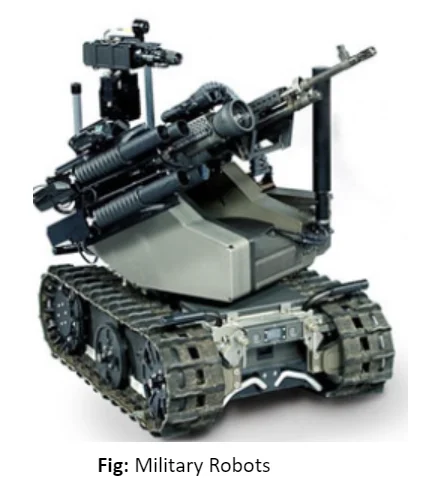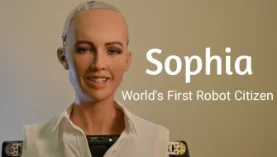Robotics, a field combining engineering and computer science, focuses on designing, building, and using robots to perform tasks autonomously or semi-autonomously. Initially developed for industrial applications, robots now serve various sectors, including healthcare, agriculture, and space exploration. Types of robots range from industrial and service robots to autonomous vehicles and humanoid assistants. As robotics technology evolves, it promises to enhance efficiency, safety, and convenience across many aspects of daily life.
Types of Robots
-
-
- Articulated Robots: These robots have rotary joints and can move in multiple planes. They are commonly used in manufacturing and assembly lines.
- SCARA Robots (Selective Compliance Assembly Robot Arm): These robots have rigid arms and are often used for tasks that require precision, such as electronics assembly.
-
-
- Medical Robots: Used in healthcare settings for tasks such as surgery (surgical robots), rehabilitation, and patient assistance.
- Cleaning Robots: Robotic vacuum cleaners and floor scrubbers fall into this category, performing automated cleaning tasks.
- Personal Assistant Robots: Designed to assist individuals with various tasks, such as communication, reminders, and information retrieval.
-
-
- Unmanned Aerial Vehicles (UAVs or Drones): Used for surveillance, photography, agriculture, and various other applications.
- Autonomous Cars: Self-driving vehicles that use sensors and AI to navigate roads safely.
-
-
- Rovers: Designed to explore the surface of planets and moons. Examples include NASA’s Mars rovers.
- Satellite Servicing Robots: Used for maintenance and repair of satellites in orbit.

-
-
- Unmanned Ground Vehicles (UGVs): Used for reconnaissance, bomb disposal, and other military applications.
- Unmanned Aerial Vehicles (UAVs): Drones used for surveillance, reconnaissance, and sometimes for offensive operations.
-
-
- Humanoid Assistants: Robots with a human-like appearance designed to assist humans in various tasks.
- Research and Development Robots: Used in labs and research institutions to explore human-robot interaction and advance robotics technology.

-
-
- Remote Presence Robots: Equipped with cameras and displays, these robots allow users to remotely navigate and interact with a distant environment.
-
-
- Companion Robots: Designed to provide companionship and assist with social interactions.
- Educational Robots: Used in educational settings to teach programming and robotics concepts.
-
-
- Robots Inspired by Animals: Mimic the movement and behaviour of animals for specific applications, such as exploration or search and rescue.
-
-
- A subfield of robotics that uses compliant materials like silicone, hydrogels, and textiles instead of rigid metal or plastic parts.
- This makes them more adaptable and safer for interacting with humans and delicate environments.
- Potential applications include surgery, prosthetics, search and rescue, and even food handling.
-
- A type of soft robot made primarily of hydrogel, a soft, water-based material.
- Hydrogels can be designed to be responsive to stimuli like temperature, light, or chemicals, giving gelbots unique capabilities.
- For example, some gelbots can change their shape or stiffness on demand, while others can sense and react to their surroundings.
Applications of Robots
Manufacturing and Assembly: Robotic arms and automated systems are commonly used in manufacturing for tasks such as assembly, welding, painting, and quality control.
- They can enhance efficiency and precision in production lines.
- Healthcare: Surgical robots assist surgeons in performing minimally invasive surgeries with greater precision.
- Robots are also used for tasks like medication dispensing, patient care, and rehabilitation therapy.
- Agriculture: Agricultural robots, known as agribots, are used for tasks like planting, harvesting, and monitoring crop health.
- Drones equipped with sensors are also employed for crop surveillance.
- Logistics and Warehousing: Autonomous mobile robots (AMRs) are used in warehouses for tasks such as picking and packing, inventory management, and material handling.
- They can navigate through environments and collaborate with human workers.
- Exploration: Robots are used in space exploration to explore planets, moons, and other celestial bodies.
- Rovers like NASA’s Mars rovers, for example, have been sent to gather data and conduct experiments on other planets.
- Defense and Security: Unmanned Aerial Vehicles (UAVs) or drones are used for surveillance, reconnaissance, and sometimes combat.
- Bomb disposal robots are employed to handle and dispose of explosive devices safely.
- Education: Educational robots are used to teach programming and problem-solving skills to students.
- These robots are often designed to be easily programmable and can be used in STEM (science, technology, engineering, and mathematics) education.
- Entertainment: Robots are used in the entertainment industry, ranging from animatronics in theme parks to robotic characters in movies.
- They can simulate human movements and interactions.
- Domestic and Personal Use: Robotic vacuum cleaners, lawn mowers, and other household robots assist with daily chores.
- Social robots, designed for companionship, are also being developed.
- Environmental Monitoring: Robots equipped with sensors are used for environmental monitoring in areas such as oceans, forests, and disaster-stricken regions.
- They can collect data on temperature, pollution, and other environmental factors.
- Construction: Construction robots can assist in tasks like bricklaying, concrete pouring, and demolition.
- They can enhance efficiency and safety in construction sites.
Biorobotics
Definition: Biorobotics is an interdisciplinary science that draws inspiration from nature to design and build robots.
- It blends principles from biology, engineering, and computer science to create robots that are more efficient, adaptable, and robust than traditional machines.
- Two Main Approaches:
- Biomimicry: This involves directly mimicking the structures, functions, and control systems of biological organisms. Examples include:
- Cheetah-inspired robots: Running robots with flexible spines and legs, mimicking the energy-efficient locomotion of cheetahs.
- Gecko-inspired grippers: Robots with adhesive surfaces inspired by gecko feet, allowing them to climb walls and handle delicate objects.
- Fish-inspired underwater robots: Undulating robots inspired by fish swimming, offering efficient and maneuverable underwater movement.
- Bio-inspired algorithms and control: This focuses on developing robot control systems inspired by biological processes like learning, adaptation, and evolution. Examples include:
- Evolutionary algorithms: Optimizing robot behavior through simulated evolution, mimicking the Darwinian process.
- Swarm intelligence: Robots collaborating and making decisions based on local interactions, similar to ant colonies or bird flocks.
- Neural networks: Robot control systems inspired by the structure and function of the brain, enabling learning and adaptive behavior.
India’s Advancement in Robotics
India is one of the emerging countries in the field of robotics and artificial intelligence.
- The Indian government, startups, and research institutes are working on various initiatives and projects to develop and deploy humanoid robots, autonomous mobile robots, and AI-based solutions for various sectors and domains.
- Some examples of India’s advancement in robotics:
- Manav: India’s first 3D-printed humanoid robot, developed by A-SET Training and Research Institute.
- Manav can walk, talk, dance, and perform various activities in response to human commands.
- It uses an open-source code and has WiFi and Bluetooth connectivity.
- Mitra: A humanoid robot that can interact with humans smartly, developed by Invento Robotics.
- Mitra can greet customers, use facial and speech recognition, and understand multiple languages. It also has a touchscreen on its chest for interaction.
- Mitra was launched by Prime Minister Narendra Modi and Ivanka Trump at the Global Entrepreneurship Summit (GES) conference in 2023.
- Robocop: A police robot that can assist in handling law and order, developed by H-Bots Robotics. Robocop can salute, shake hands, recognise faces, and identify suspects.
- It can also communicate with the police control room and alert them in case of emergencies.
- AI Centers of Excellence: The national Artificial Intelligence (AI) Mission will include creating Centres of Excellence (CoE) for AI-related research and development.
- There will be a National Centre for Transformation AI and several domain-specific CoEs for healthcare, agriculture, education, smart cities, etc.
- US-India AI Initiative: A flagship program launched by the Indo-US Science and Technology Forum (IUSSTF) to foster AI innovation and collaboration between India and the USA.
- The initiative will bring together key stakeholders from both countries to share ideas and experiences, identify new opportunities, and address common challenges in AI.
Conclusion
- Robotics is transforming industries and improving lives through advancements in automation, precision, and functionality.
- From India’s innovative projects like Manav and Mitra to global applications in manufacturing, healthcare, and beyond, the impact of robotics is vast and growing.
- The field’s interdisciplinary nature, especially through biorobotics, highlights the potential for creating adaptable and intelligent machines. As research and development continue, robotics will undoubtedly play a pivotal role in shaping the future.
![]() June 11, 2024
June 11, 2024
![]() 2583
2583
![]() 0
0

